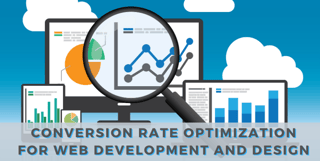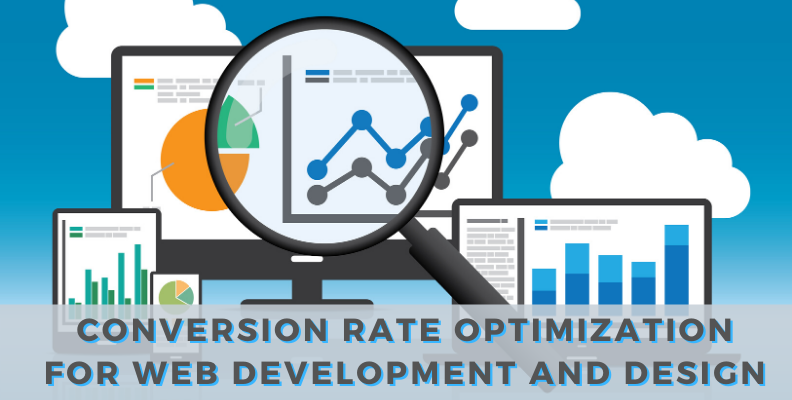
What is conversion rate optimization?
You may have heard the term Conversation Rate Optimization or CRO. But what is that exactly? CRO is the practice of improving the performance of any sales, marketing, advertising or other business facets with the goal of getting the user to perform a specific action. In this article, we will be focusing on the CRO of websites specifically. Whether you're designing a new website or embarking on a website redesign, CRO should be a crucial piece of your overall strategy. Unlike Search Engine Optimization which focuses on ranking factors used by Google's algorithm, CRO focuses on human behavior. Whether your goal is to generate leads through a landing page form submission, purchasing a product from an eCommerce website or opting into a mailing list, all of these are defined goals a business wants to move the needle on. CRO is the process by which they improve these numbers incrementally over time. Evaluating analytics, looking at heat maps and user recordings, making changes to design and copy, are all part of conversion rate optimization.
So how do you do conversion rate optimization anyway?
First, you will need to define a goal. Without a specific goal, you have no framework to measure progress against. Your goal should be meaningful, attainable and measurable. Your goal could be the number of demo requests by the end of the year. Or increase your newsletter subscription base to 3,000 by end of Q3. It can even be a specific number like close $3M in revenue by 2020. Whatever your goal is, it should provide the direction which should guide all of your CRO efforts.
Next, you'll need to collect some data. It's always better to base your efforts on data instead of personal preference or assumptions. Gaining a clear understanding of how your webpage is currently performing is crucial in guiding the changes you want to make in order to increase the overall performance. Data can come from a variety of sources. Some of the most common types of data are:
- Page analytics - which comes from software like HubSpot and/or Google Analytics.
- Heat maps - that come from programs like Lucky Orange, Hot Jar or Crazy Egg.
- SEO performance - data that can come from places like SEMRush and MOZ.
Depending on what you're trying to optimize, you may use more of one type of data than another. For example, if you've just launched a new landing page for a paid search campaign, you may not be as interested in how people get to the page as you are about what they do once they're there. In which case, you'd be more inclined to view heat maps and user recordings of the traffic that has made it to the page as opposed to evaluating how they got there. But what do you do once you have the data?
The Process
To start the CRO process, we revisit the first step in establishing our goals. Let's use the example of demo requests. You know that your monthly average of submissions was 5 or about .01% last year. But you want to increase that to .02% by the end of this year. Your goal would be to "increase the average number of monthly submissions from 5 to 10 by the end of 2020". Great! Now we know what we are striving for.
After you collect the data you analyze it to find trends. Are there certain parts of the page that are getting more attention than others? Are people abandoning filling out the form at a certain point? Do user recordings indicate users scrolling up and down a furious pace? All of these observations are in an effort to generate a hypothesis. Your hypothesis is the framework by which you will start testing.
Testing is the next step. As Neil Patel wrote in his blog 7 Lessons I’ve Learned from CRO Tests that Generate Hundreds of Millions of Dollars
Optimization kicks in when you take the same page you’ve been tracking and start changing elements to see if you can get more conversions.
Once you have your hypothesis, you begin testing different approaches or changes. Let's say you identified an issue with the form on the landing page. People start engaging with it but then abandon it. You notice that your form has 15 different pieces of information it's asking for. Sure some of the standard first name, last name, etc. But you also have a couple of larger form fields where you want the user to describe their problem or provide a scope of work. You theorize that you may be asking too much from the audience and it's causing people to leave. This may lead you to remove the message fields and streamline the form a bit. So you publish the new form and begin collecting data. After about a month you notice that your form submissions increased over the previous month. Instead of 5 last month you acquired 7 or 8 this month. You have just performed CRO!
How to make it a habit.
You may have heard about the term Growth Driven Design. GDD is a methodology that came from Luke Summerfield with HubSpot. A major component of GDD is what is known as the "continuous improvement cycle". This is the most crucial part of any website and one that is usually most overlooked by upper management. A website is a living, breathing thing and you should always be monitoring, testing, improving and growing your website over time. This is where CRO becomes a powerful tool for your business.
When you originally design or redesign your website you will have some ideas of what you want it to do. Getting a jump start right after your website goes live allows you to start testing right away. First, begin with your intended action items. You're essentially at "the process" phase of this blog post already!
GDD Approach - One effective way to implement CRO in your continuous improvement cycle is to utilize sprints similar to an agile methodology. Over the course of a sprint, you should have a focus metric and center all of your evaluation efforts around that particular metric. Once you have your data you can begin testing. Be mindful not to test too many different variables at once. If you change the color of your call to action button, along with the verbiage on it, and moved it to a different location on the page, you run the risk of not knowing which of those was actually effective in improving your click-through rate. Taking this approach, you can always be monitoring one metric while you're testing another each sprint. Now your sprints can be a couple of weeks, a month, or more. But be careful! There are a lot of outside variables that can also affect the performance of your website. Seasonality, different marketing efforts, content publication and more, can all influence your tracking so take these into account frequently.
Implementation - After testing your hypothesis for a sprint, if the results indicate an improvement, try to replicate that with another page on the website. If you improved the submission rate of a popular landing page, try applying what you learned to an underperforming page to see if your findings are consistent for your audience. If your hypothesis was not correct and you find your conversion rates actually went down, revert and evaluate to see if you can identify what exactly caused that.
Conversion Rate Optimization is not a quick fix. It's not a "study for the final, take the test and go home" type of situation. It's an ongoing, ever-evolving process of testing and evaluating hypotheses over time so that you can leverage your website to its fullest potential. Sometimes hypothesis turn out to be wrong, but that's not always a bad thing. Because your website should never be finished, and you will always be looking toward growth in the future. Because of this, even the incorrect hypothesis gives you valuable data and insight into your audience, your website and often times your own business. Make that data work for you and test an alternative or go back and retest to confirm your suspicions. You'll be amazed that even the smallest changes can have some of the largest impacts.


